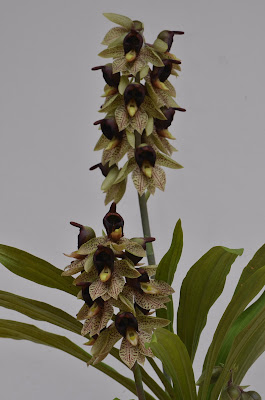Catasetum naso is found from Colombia to Venezuela. It grows in lowland to moderately elevated forest.
Catasetum naso also called as The Nose Catasetum, Catasetum naso var. pictum, is a species of the genus Catasetum. This species was described by John Lindley in 1843.
IDENTIFY CATASETUM NASO ORCHID PLANT
Catasetum naso is found from Colombia to Venezuela. It grows in lowland to moderately elevated forest.
It is a medium sized, hot to cool growing epiphyte with fleshy, white roots and fusiform, to 14 cm long and 2 cm wide pseudobulbs carrying 6, linear-lanceolate, medium green, plicate, 35 cm long and 5 cm wide leaves.
The Nose Catasetum blooms in the fall on a erect to arcuate, 38 cm long, few to several flowered inflorescence carrying very fleshy, heavily fragrant flowers. The male flowers are 4-8 cm in diameter with coloration of sepals and petals green, spotted with very dark red; lip entirely very dark red to almost black. The female flowers are not seen. The var. charlesworthii has a very deep wine-purple lip, and a midlobe with a crest in the middle and filiform teeth over its surface.
This species is widely confused with Catasetum sanguineum. The main distinguishing feature seems to be the lacerate appendages on the lateral lobes of the lip. In Catasetum naso, only the margins at the base are lacerate, whereas in Catasetum sanguineum all margins of the lateral lobes are lacerate. Furthermore, the pedicels of Catasetum naso are longer.
CATASETUM NASO ORCHID PLANT CARE AND CULTURE
Cultural information should only be used as a guide, and should be to be adapted to suit you. Your physical location; where you grow your plants, how much time you have to devote to their care, and many other factors, will need to be taken into account. Only then can you decide on the cultural methods that best suit you and your plants.
Light:
Catasetum are sun-loving plant and needs a light level of 30000-60000 lux. Unless the strong air movement found in the natural habitat can be duplicated, however, the grower should provide some shade (40-60 % shade). This species can be grown under lights if sufficient light intensity can be provided, and the plant certainly can be summered outdoors if their moisture requirements can be met.
Temperature:
Their climate is tropical to subtropical, with dry, near desert-like conditions. It has an even longer dry season and low humidity almost year-round. Most of the moisture results from nighttime dews. Temperatures range from a maximum 40°C to a minimum 15°C. In cultivation, 18°C is the ideal minimum night temperature.
Humidity:
The Nose Catasetum tolerate an environment with 40 - 60 % relative humidity during their growing season, but for optimal development of new growth and flowering, 70 % is recommended.
Substrate, growing media and repotting:
Catasetum naso should be potted in wood and bark chips or grown in a wooden basket for best results. It is recommended to repot every year and never wait more than two years. The optimal time for potting or repotting is when new growth on a plant emerging from dormancy is about 5 cm tall and the nubs have developed into new roots that are reaching for support.
Watering:
In its natural habitat it receives rainfall frequently even while dormant. Basket-grown, and unconventionally potted plant may be watered every sunny day during the growing season, provided conditions are such that they dry off relatively quickly. In the case of conventionally potted adult plants, it should not be necessary to water more than once or, at most, twice a week. This species like to dry out at least slightly between waterings.
Fertilizer:
Fertilize with an appropriate formulation at least every week during the growing season, or fertilize with a weak formula every time the plants are watered. It is important to begin regular applications of high-nitrogen fertilizer (such as 10-5-5) with a full range of trace elements. As the leaves begin to unfurl, and well before flowering, add a high-phosphorus formula to develop big, strong pseudobulbs capable of producing robust inflorescences. Any of the soluble products with a large second-digit number (for example, 3-12-6) constitute a good source of phosphorus.
Rest period:
When the Catasetum naso plants are leafless and no new growths are visible, the grower must respect their state of dormancy. Watering frequency should be reduced during dormancy. Fertilization should stop completely during this period. In the springtime, at the beginning of the growth cycle, water should not be made regularly available for the newly developing roots until the new growth is at least 5 cm tall.















COMMENTS